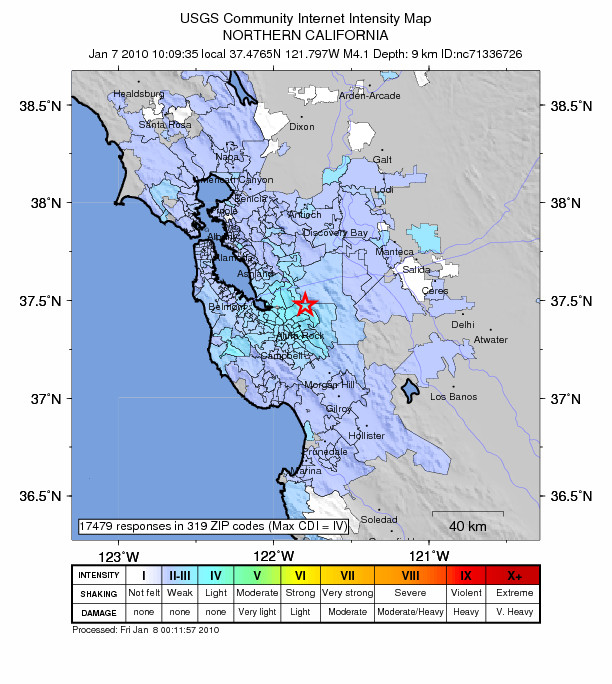Seismo Blog
Did You Feel It?
Categories: Bay Area | Earthquake Faults and Faulting | Calaveras | Did You Feel It?
January 7, 2010
After a hiatus of almost three months, the blogger was shaken back into action this morning by the strongest temblor to hit the Bay Area in nearly a year. At 10:09 am PST a magnitude 4.1 earthquake occurred on the Calaveras Fault with its epicenter roughly six miles eastnortheast of Milpitas. Its hypocenter - the starting point of any earthquake - lay at a depth of approximately seven miles beneath the surface.
In today's interconnected world, it is very easy even for lay people to get immediate information about each tremor one feels. No, I am not talking about the emotional outbursts which hit the Twitters and Facebooks of the cyberworld ("Wow, how did I feel it shake!") after each reasonably sized shaker. I mean the reliable information, which a dedicated cadre of Bay Area earth scientists puts together with the help of mostly automated computer algorithms and which are posted on the web, as soon as they are available. My first stop while cybershopping for information about recent Bay Area earthquakes is always the map of the latest epicenters . It is published jointly by the United States Geological Survey (USGS) in Menlo Park and the Berkeley Seismological Laboratory, which also hosts this blog. Color coded and sorted by size, you will easily find the latest temblors. The map is updated immediately when a new earthquake occurs and carries all quakes, which occurred during the week before the latest event. Click on one of the squares and you will be directed to much more detailed information about this specific quake and its location within the tectonic framework of the Bay Area.
But the advances of web communication do not only benefit the public while looking for earthquake information. You can also be part of the advancement of seismology and help the researchers, by reporting on what you have felt during the shaking of an earthquake. The USGS has set-up a website under the headline "Did you feel it?", where you can access a questionnaire. You will be asked a dozen or so questions about how and where you felt it, how strong you experienced the shaking and if you detected any damage in your building or in structures around you. It does not take more than five minutes, to fill out the online form. The information is handled confidentially, although you may enter your name and communication parameters, if you think, that your earthquake observations warrant more attention by the researchers.
You will ask, how such responses can advance science. Because neither the Earth nor its earthquake faults are homogeneous and simple, seismology has to deal with lots of variables. No two earthquakes are the same and the shaking induced by seismic waves can vary consideraby even over a short distance. The topography, the type of soil and the structure of the underlying base rock determine, how strong a specific location rattles during a temblor. As scientists cannot place a seismometer on every square yard of the Bay Area and because such variations cannot be computed theoretically, the researchers need observations from the field - and that means from you, the person who has felt the quake. A lot of people contribute to the website already. In the first hour after today's quake, more than 15000 had submitted their observations, including the blogger. But because a wider response is always welcome, hit the keyboard the next time you feel a quake and look for "Did you feel it?" (hra047).
BSL Blogging Team: Who we are
Recent Posts
-
: Alerts for the Whole West Coast
-
: Destruction in the Eastern Aegean Sea
-
: An Explosion in Beirut heard all over the Middle East
View Posts By Location
Categories
- Alaska (3)
- Bay Area (24)
- Buildings (3)
- Calaveras (4)
- California (13)
- Central California (4)
- Chile (4)
- Earthquake Early Warning (10)
- Earthquake Faults and Faulting (44)
- Earthquake Science (3)
- Haiti (3)
- Hayward (12)
- Indonesia (4)
- Induced Seismicity (3)
- Instrumentation (18)
- Italy (6)
- Japan (7)
- MOBB (3)
- Mendocino Triple Junction (5)
- Mexico (7)
- Nepal (3)
- North Korea (5)
- Nuclear Test (5)
- Ocean Bottom Seismometer (3)
- Oklahoma (4)
- Plate Tectonics (18)
- Preparedness, Risks, and Hazards (15)
- Salton Sea (3)
- San Andreas Fault (14)
- Seismic Waves (13)
- Seismograms (4)
- ShakeAlert (3)
- Southern California (5)
- Surface Waves (3)
- Today in Earthquake History (20)
- Volcanoes (4)
- subduction (3)
